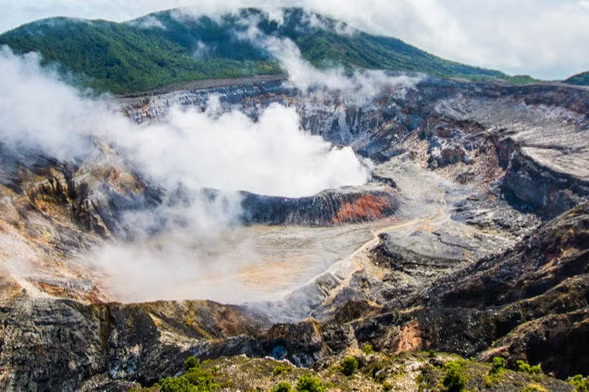In the verdant heart of Costa Rica, the Poás Volcano’s once bountiful lake teeters on the brink of extinction, setting the stage for an increase in minor eruptions and gas emissions. This geological drama unfolds against the backdrop of the Poás Volcano National Park, which remains open as the activity does not yet pose a risk to its visitors. However, the ever-changing winds bear a silent threat: the potential for acid rain in the surrounding areas.
A Lake’s Last Gasp: Vanishing Waters and Escaping Gases
The crater lake of Poás, a once-thriving aquatic gem, is succumbing to a combination of scarce rainfall, brisk trade winds, and relentless fumarolic activity. These forces conspire to evaporate the water, leaving gas vents exposed and free to release their contents more effortlessly into the atmosphere.
Eruptive Whims of a Restless Colossus
Recent hydrothermal eruptions, like the one on January 15th, sent materials soaring over 200 meters above the crater. Subsequent eruptions, though less vigorous, have painted a vivid picture of the volcano’s restless nature. Vulcanologists Cyril Müller and Javier Pacheco from the Costa Rican Volcanological and Seismological Observatory (Ovsicori) warn that intensified activity coupled with strong winds could usher in acid rain to the west of the crater.
Acid Rain: A Silent Menace
Acid rain, a cocktail of sulfur gases reacting with the atmosphere to form hydrogen dioxide droplets, poses a threat to local flora and metallic structures. While currently confined to the National Park, there is no immediate alert for the agricultural sector in nearby cantons like Zarcero, Grecia, and Naranjo, which previously suffered crop damage due to volcanic activity in 2017 and 2018.
On Alert: Close Monitoring of Poás
The National Emergency Commission (CNE) collaborates closely with Ovsicori to track changes in the volcano’s behavior, as the frequency of small eruptive events has risen since the previous December. The park remains open, but sudden temporary closures are not ruled out in case of increased eruptions or gas emissions. Precautions include proper signage, shelters, and park rangers equipped with gas detectors.
Technological Vigilance
Ovsicori continues its vigil with seismometers detecting vibrations from ruptures or flows, GPS systems for volcanic deformation, and a multi-gas station to monitor gas emissions. To date, there are no signs of fresh magma rising, as evidenced by the lack of internal seismic activity and the relatively low height of the eruptions.
Preparedness and Public Safety
The CNE, alongside the park’s administration, is revising emergency management plans and conducting training sessions with park rangers to reinforce protocols for potential emergencies. Blas Sánchez, a geologist with the CNE, emphasizes that the Technical Advisory Committee in Volcanology is analyzing the activity, which currently poses no risk to visitors. Rangers can implement preventive closures when high gas concentrations are detected, ensuring the safety of tourists.
Visitor Engagement Amidst Natural Turmoil
In 2022, the Poás Volcano National Park welcomed over 214,399 local and international nature enthusiasts, with 163,607 visitors recorded up to August of that year. Amidst the increase in volcanic activity, warnings are issued to those entering illegally or through restricted areas about the heightened risk and impact of the gases.
As Costa Rica grapples with the shifting moods of Poás Volcano, a story of natural resilience and human tenacity unfolds. The nation’s commitment to understanding and coexisting with its fiery giants continues to inspire awe and respect for the forces of nature.


1 comment
[…] Source link […]